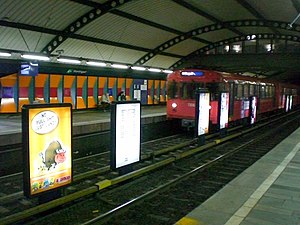Stortinget station
Stortinget is an underground
There has been a tram stop at Tinghuset since the opening of the
History
The first underground railway to serve Oslo was the extension of the

During the 1960s, the
At the time, the western and eastern networks were incompatible; in addition to different platform heights, the eastern network used six-car trains with a
The decision to build Sentrum Station was taken by the city council on 22 May 1969; the decision also involved that the transfer station be placed at Slottsparken/Nationaltheatret. Construction started in 1972, and the first leaks were revealed. By the time the station opened on 9 January 1977, the leaks had not been removed.[8] During trials in January, it turned out that the tracks were too low for all types of trains to be able to open their doors, causing the tracks to have to be raised.[9] By 1978, the contractor and the municipality felt that the leaks were under control, and the municipality took over the station. In February 1983, the station was closed to finally remove all leaks. At the time, it was expected that the station could reopen in 1984.[8] The leakages were caused by two sources: the use of the wrong type of concrete, and the wrong construction method. These were specified correctly in the tender contracts, but after the contractor was chosen, an agreement was made between the municipality and Selmer for the use of the membrane method. Combined with the inferior quality of concrete, the leaks were unavoidable.[10] In 1986, the municipality sued Selmer for the 158 million kr it cost to repair the station.[11]
The station reopened on 7 March 1987, with the new name Stortinget. The name derives from the Parliament of Norway (
Facilities

Stortinget has four
Service
Stortinget is served by all five lines of the Oslo Metro. The station is considered the heart of the system, and is 'kilometer marker zero' for measuring all distances. All services have a 15-minute headway. The metro is operated by
The trams running through Grensen and Pilestredet serve the tram stop Tinghuset (the courthouse) next to one of the Metro entrances. The stop is served by lines 17, 18 and 19 of the Oslo Tramway. Westwards, line 17 and 18 operate along the
References
- ISBN 82-91448-03-5.
- ^ "Både jernbane og T-bane under Oslo sentrum". Verdens Gang. 20 March 1967. p. 4.
- ^ a b Sundene, Thor Fr. (30 July 1975). "Plansjefene får konkurranse". Verdens Gang. p. 12.
- ^ Sundene, Thor Fr. (28 June 1976). "Øst–vest T-bane mulig om få år". Verdens Gang. p. 14.
- ^ Sundene, Thor Fr. (11 February 1976). "De fraskriver seg ansvaret!". Verdens Gang. p. 10.
- ^ Sundene, Thor Fr. (14 February 1975). "Seier for de reisende". Verdens Gang. p. 10.
- ^ Sundene, Thor Fr. (18 November 1978). "T-banen tvers gjennom Oslo". Verdens Gang. p. 15.
- ^ a b Mathismoen, Ole (19 March 1987). "Foto avslører SelmerFuruholmen?". Aftenposten. p. 13.
- ^ "Sentrum T-banestasjon åpner". Norwegian News Agency. 5 March 1977.
- ^ "Kritikk, rot og trøbbel". Verdens Gang. 2 August 1985. p. 7.
- ^ "Saksøker Selmer". Norwegian News Agency. 25 September 1986.
- ^ a b Wiik, Karsten (24 January 1987). "Hatten av for Stortinget stasjon". Aftenposten. p. 16.
- ^ Fristad, Hans Andreas (24 January 1987). "Efter 90 års utbygging: Tunnelbanenettet endelig fullført". Aftenposten. p. 16.
- ^ Ruter (2008). "Tidslinje" (in Norwegian). Archived from the original on February 20, 2009. Retrieved 21 March 2009.
- ^ Ruter (18 August 2008). "Rutetider T-banen" (PDF) (in Norwegian). Retrieved 21 March 2009.[permanent dead link]
- ^ Ruter (30 March 2008). "Sporvogn" (PDF) (in Norwegian). Archived from the original (pdf) on September 20, 2008. Retrieved 19 March 2009.
External links
![]() Media related to Stortinget stasjon at Wikimedia Commons
Media related to Stortinget stasjon at Wikimedia Commons


